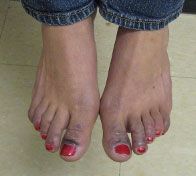An Active 15-Year-Old Girl With a Rash on Both Feet
A15-year old girl presented with a rash on both feet that had appeared a month earlier. Initially the rash looked like bruising at the base of both large toenails.

A 15-year-old girl presented with a rash on both feet that had appeared a month earlier. Initially the rash looked like bruising at the base of both large toenails (Figure 1); it then spread as purple macules and papules to the plantar and dorsal surfaces of several toes. The lesions were slightly itchy at times, but not painful, and had steadily increased in number over the past few weeks.
The patient plays competitive soccer and had played 4 games in the cold rain before the rash appeared but said her feet hadn’t been injured. There were no other lesions on her legs or torso. The rash hadn’t developed in her family members and the family had not traveled recently.
The patient’s medical history included exercise-induced asthma and chronic headaches. She was using inhaled beclamethasone and albuterol for asthma and amitryptyline 30 mg daily to prevent headaches She appeared well, had no fever, and her vital signs were normal.
The patient’s toes appeared dusky in color and were cold to the touch. The purple skin at the base of the big toenails was not tender and there were no ulcerations or blisters. There were multiple erythematous, violaceous papules on both feet, primarily on the toes (Figures 2 and 3). The rest of her skin was clear. The patient refused a skin biopsy because it would interfere with her active soccer schedule.


Laboratory values were normal for ANA, CBC, cryoglobulins, and CH50. A cold agglutinins titer was elevated (1:80; normal, none detectable).
"WHAT'S YOUR DIAGNOSIS?"
Diagnosis:Pernio
Pernio is an uncommon condition, also known as chilblains.
Pernio is a localized inflammatory condition that causes erythematous purple or red macules and papules on the toes or fingers. It can cause intense pain, itching, or burning. Pernio occurs most often in young women between the ages of 15 and 30 years but can also occur in older adults and younger children following exposure to nonfreezing cold.
The etiology of pernio is unclear although the presence of cryoproteins in some patients may amplify a cold injury, as this case illustrates. The cause of cryoproteinemia also is uncertain but might be the result of a recent viral and Mycoplasma infection, though no such history was present in this case. Factors that may predispose to pernio include anorexia nervosa, thin body habitus, systemic lupus erythematosus, and rheumatoid arthritis.
The most effective treatment is to keep the affected areas warm and dry. Topical corticosteroids are not effective. Oral therapy with the vasodilator nifedepine can help reduce pain and facilitate healing in some patients.
The patient in this case began taking meticulous care to keep her feet warm and dry. The lesions improved significantly.
References:
Weston W, Morelli, J. Childhood pernio and cryoproteins. Pediatr Dermatol. 2000;17:97-99.
Simon T, Soep J, Hollister R. Pernio in pediatrics. Pediatrics. 2005;116:472-475.
Recognize & Refer: Hemangiomas in pediatrics
July 17th 2019Contemporary Pediatrics sits down exclusively with Sheila Fallon Friedlander, MD, a professor dermatology and pediatrics, to discuss the one key condition for which she believes community pediatricians should be especially aware-hemangiomas.